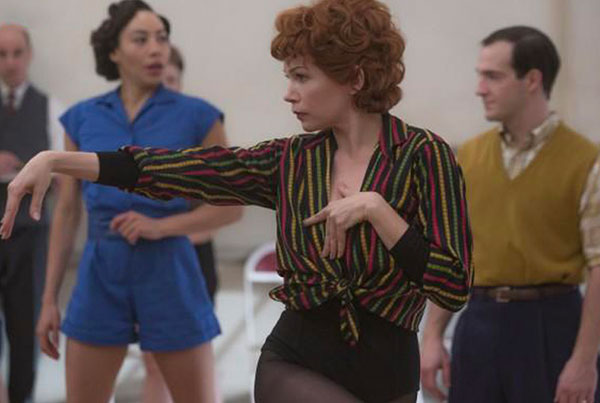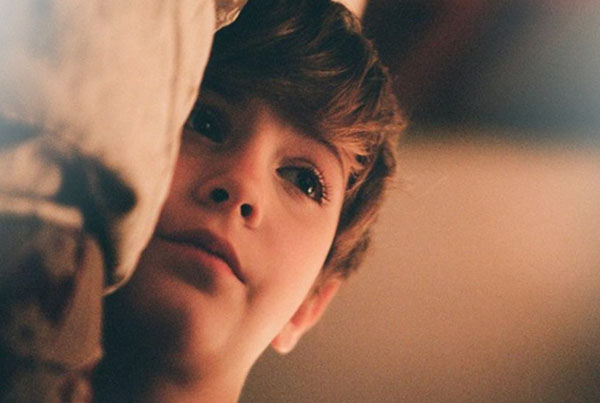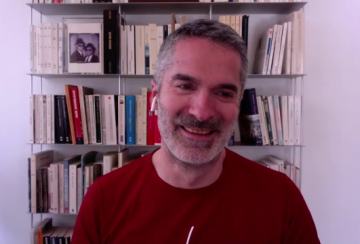Fosse/Verdon – Dancing with death
Miniserie. He revolutionized Broadway, received 8 Oscars for Cabaret
and a Palme d’or for All That Jazz…
The choreographer and director Bob Fosse is the hero of a biopic
with Sam Rockwell and Michelle Williams.
By Caroline Veunac
![]() Reading time 6 min.
Reading time 6 min.
« Hollywood, 19 years before » : opening with this message, white letters on a black background, the miniserie Fosse/Verdon (on FX in the USA on April 9th) takes the shape of an obituary right away. From scene to scene, the countdown has begun, but it’s not linear, and Bob Fosse is more or less close to his death’s hour. This sort of narration is directly inspired from the semi-autobiographical masterpiece of the American choreographer and director, All That Jazz (we can see here the opening scene) is itself a sort of funeral march going back and forth in time.

married and bound to
dance
no matter what
Using the same method, Fosse/Verdon‘s team composed of Sam Wession (author of Bob Fosse’s bio) and of the successful musical Hamilton‘s producers, intend to pay a tribute to Broadway’s absolute master. It’s also a way to highlight the majo theme of Fosse’s work (interpreted by Sam Rockwell) : the complex pas de deux between showbiz and death. This duality is visible here though his relationship with the love of his life, Gwen Verdon (played by Michelle Williams, who’s really a great actress), another star on the boards who has been his wife and co-worker for 25 years.
« It’s showtime, folks ! »
She is strong and has a sunny disposition; he is sensitive and devious. This opposition would have seemed a little cliché if only Bob Fosse wasn’t full of gloomy references to showbiz’ vanity. In All That Jazz, his double, embodied by Roy Scheider, gets up every morning and talks to himself in the mirror saying « It’s showtime, folks ! » less and less convinced, before he knocked a cocktail of pills back. In Cabaret, directed seven years before, he had Liza Minelli to dance in the 30’s decayed Germany. And in Star 80, his last film, he comes back on Dorothy Stratten’s story, the tragically famous Playboy‘s star, murdered by her husband, jealous that showbiz had taken her away.
Where does Fosses’ obession for the dark side of entertainment industry come from? We can blame the miniserie for being too didactic but at least it gives us clarifying informations. Bob Fosse was born in 1927 in Chicago and he has 5 brothers and sisters. Fifty years later, he confessed to the New York Times : «I come from a large family, maybe they didn’t not pay attention to me…». To stand out from the crowd, he dances. He realized it was a vocation when he was 9, but it became real during Second World War: In the Pacific, when he wasn’t even 18, he performed in a show going from naval base to naval base so as to entertain the marines. A tap dance in order to forget they might die… Bob Fosse’s destiny becomes clearer: he will be one of the entertainers who inherited war, who will turn showbiz into a shield as shiny as pathetic against our upcoming death.
Oscars, Emmy and Tony Award 1973
In the late 40’s, Bob Fosse landed in New York. He can already picture himself as Gene Kelly, Fred Astaire… He will “only” be the greatest choreographer Broadway has ever had. Full of physical complexes, obsessed with his hands he hides with gloves, and with his nascent baldness he hides with a hat, Fosse choses the shadow of rehearsal studios. His creations in Broadway are successful. In 1969, he directs his first film, Sweet Charity. But he regrets he has not become the dancer of his childhood dreams. His love and professional passion with Gwen Verdon, whom he met on the set of the musical Damn Yankees in 1955 and got married with five years later, is not enought to fill this void. Fosse seduces anything that moves in order to have the feeling he exists. And his obsessive relationship with art swallows everything up. “Life is when you walk on a tight wire. The rest of the time, you are waiting”, he has the heroe of All That Jazz say. And he himself admits during an interview given to the New York Times: “I’m a quite good husband when I don’t work, but as soon as a project beins, it’s as if nothing else mattered to me”. As he’s never present and keeps on cheating on her, the couple Fosse-Verdon is endgame in 1971, even if they will legally stay married and bound to dance until the very end.
Regrets, complexes, doubts disappearing into alcohool and pills, cigarettes burning at a rate of 4 packets per day, worrying skinniness… Creation is close to self destruction for Fosse. He even confessed being fascinated by “that thin line between a person’s jumping or not jumping, shooting himself or not shooting himself”. And if the birth of his daughter Nicole has now vaccine this bipolar person against his suicidal temptations, no glory will fully restore his broken narcissism. “I alternate between this raging ego, and thinking I’m a total fraud, thinking they’re gonna catch me”, he said during an interview with the New York Times. The year 1973 marks his destiny in black and white : while he just won the Oscar for the best film for Cabaret (stealing the victory away from The Godfather), a Tony Award for the musical Pippin and an Emmy Award for a TV show with Liza Minelli Liza with a Z, Fosse, psychologically leached, is consigned to a psychiatric hospital. Palme d’Or won in 1980 for All That Jazz, he breaks the records at the Tony Awards with eight prizes… The honors accumulate, the abyss remains.
He inspired Michael Jackson or Beyoncé
His worst anxieties, Bob Fosse uses them to sublime his baroque movies, lucid and desperate. All That Jazz, the most obvious self-portrait of himself, ends up on the unmistakable shot of a bag containing a corpse. In Cabaret, the scene where Liza Minelli performs in front of Nazis is swallowed by a black hole. In Lenny, directed in 1974, he is projected into the stand-up comedian Lenny Bruce (Dustin Hoffman, awesome), who lives his life on the edge. But Bob Fosse’s legacy is not limited to these handful feature-length mirrors. The miniseries Fosse/Verdon, which concentrates on his complicated relationship, really lacks of dancing scenes and struggles to do justice to the choreographic innovations of this groove genius. A gap all the more unfortunate that Sam Rockwell, who never misses an opportunity to dance in his films, is able to move like a god.
And yet, there was something to do. Inspired by Fred Astaire, by jazz and the vaudeville, an apostle of the mixture of genres, initiator of choreographies with a thoughtfull subtext, Bob Fosse has created a panoply of signatures-moves, gathered under the name of “Fosse Amoeba” : the rolling shoulders, knees and feet pointing inwards, fingers snapping, pelvis pushing forward, hands beating the air. This unique style will have a major influence on popular culture. Just watch on Youtube his performance in the movie of his friend Stanley Donen The Little Prince, wearing black pants too short, black gloves and white gaiters. Michael Jackson owes him everything. Twenty years after that day of November 1987 when Bob Fosse’s heart dropped, Beyoncé still invoked the spirit of the master in her Single Ladies‘ music video. The dance, finally, will have survived death.
See also




